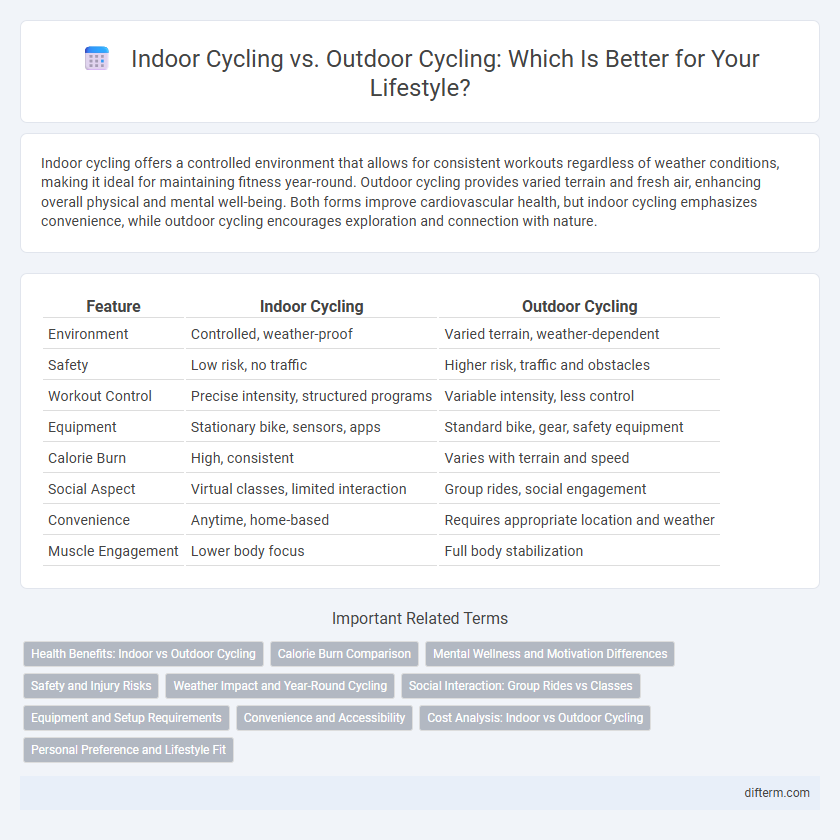Indoor cycling offers a controlled environment that allows for consistent workouts regardless of weather conditions, making it ideal for maintaining fitness year-round. Outdoor cycling provides varied terrain and fresh air, enhancing overall physical and mental well-being. Both forms improve cardiovascular health, but indoor cycling emphasizes convenience, while outdoor cycling encourages exploration and connection with nature.
Table of Comparison
| Feature | Indoor Cycling | Outdoor Cycling |
|---|---|---|
| Environment | Controlled, weather-proof | Varied terrain, weather-dependent |
| Safety | Low risk, no traffic | Higher risk, traffic and obstacles |
| Workout Control | Precise intensity, structured programs | Variable intensity, less control |
| Equipment | Stationary bike, sensors, apps | Standard bike, gear, safety equipment |
| Calorie Burn | High, consistent | Varies with terrain and speed |
| Social Aspect | Virtual classes, limited interaction | Group rides, social engagement |
| Convenience | Anytime, home-based | Requires appropriate location and weather |
| Muscle Engagement | Lower body focus | Full body stabilization |
Health Benefits: Indoor vs Outdoor Cycling
Indoor cycling offers consistent cardiovascular exercise with reduced joint impact thanks to controlled environments and adjustable resistance levels. Outdoor cycling provides enhanced mental health benefits through exposure to fresh air, varying terrains, and natural sunlight, boosting mood and vitamin D synthesis. Both forms improve cardiovascular fitness, muscle strength, and endurance, but outdoor cycling promotes greater overall sensory stimulation and calorie burn due to wind resistance and environmental factors.
Calorie Burn Comparison
Indoor cycling sessions typically burn between 400 and 600 calories per hour, depending on intensity and individual weight, while outdoor cycling can burn approximately 500 to 700 calories per hour due to variable terrain and wind resistance. The controlled environment of indoor cycling allows for consistent calorie burn, whereas outdoor cycling's fluctuating conditions may lead to increased energy expenditure. Both forms effectively promote weight loss, but outdoor cycling often results in slightly higher calorie consumption due to natural environmental challenges.
Mental Wellness and Motivation Differences
Indoor cycling offers a controlled environment that enhances mental wellness by reducing stress and improving focus through consistent rhythm and immersive virtual experiences. Outdoor cycling boosts motivation by engaging with natural surroundings and varying terrain, which stimulates dopamine release and fosters a sense of adventure. Both forms contribute uniquely to mental health, with indoor cycling promoting mindfulness and outdoor cycling encouraging social interaction and environmental connection.
Safety and Injury Risks
Indoor cycling offers a controlled environment that minimizes exposure to traffic hazards, weather conditions, and uneven terrain, significantly reducing the risk of accidents and injuries. Outdoor cycling presents challenges such as vehicle collisions, road debris, and unpredictable surfaces, increasing the likelihood of falls, cuts, and fractures. Proper safety gear like helmets and reflective clothing is essential for outdoor riders, while maintaining bike setup and posture helps prevent repetitive strain injuries in indoor cycling.
Weather Impact and Year-Round Cycling
Indoor cycling offers a consistent workout environment unaffected by extreme temperatures, rain, or snow, making it ideal for year-round training regardless of weather conditions. Outdoor cycling delivers fresh air and varied terrain but is often limited by seasonal changes such as icy roads or intense heat, which can hinder safety and comfort. Prioritizing indoor cycling ensures uninterrupted fitness routines, while outdoor cycling provides a dynamic experience that depends heavily on favorable weather.
Social Interaction: Group Rides vs Classes
Group rides foster social interaction through shared routes and varying paces, encouraging spontaneous conversations and camaraderie among cyclists of different skill levels. Indoor cycling classes create a structured environment where participants engage with instructors and peers, often building community through synchronized workouts and motivational music. Both settings enhance social connections but vary in dynamics, with outdoor rides offering unpredictable social encounters and indoor classes providing consistent, collective energy.
Equipment and Setup Requirements
Indoor cycling requires a stationary bike with adjustable resistance settings, a sturdy frame, and often accessories like a fan, heart rate monitor, or cycling shoes for optimal performance. Outdoor cycling demands a lightweight, durable road or mountain bike equipped with gears, brakes, and appropriate tires for various terrains. While indoor cycling setup is compact and weather-independent, outdoor cycling involves additional gear such as helmets, gloves, and safety lights for protection and visibility.
Convenience and Accessibility
Indoor cycling offers unmatched convenience by providing a controlled environment free from weather disruptions, traffic, or terrain challenges, making it accessible year-round. It requires minimal preparation and allows workouts to fit into tight schedules, ideal for urban dwellers with limited outdoor cycling options. Outdoor cycling, while offering natural scenery and varied routes, depends heavily on weather conditions, daylight, and safe infrastructure, which can limit accessibility for many individuals.
Cost Analysis: Indoor vs Outdoor Cycling
Indoor cycling requires an upfront investment in a stationary bike, ranging from $500 to $2,500, while outdoor cycling involves purchasing a bicycle, helmets, and maintenance gear, often exceeding $1,000. Monthly costs for indoor cycling include subscription fees for virtual classes, typically $10 to $40, whereas outdoor cycling expenses cover maintenance, repairs, and occasional gear upgrades. Over time, indoor cycling offers predictable costs mainly tied to equipment and subscriptions, while outdoor cycling can incur variable expenses due to weather-related repairs and replacement of parts.
Personal Preference and Lifestyle Fit
Indoor cycling offers convenience and climate control, making it ideal for those with busy schedules or limited access to outdoor routes. Outdoor cycling provides a dynamic environment and fresh air, appealing to individuals who enjoy nature and varied terrains. Choosing between the two depends on personal preference, fitness goals, and lifestyle compatibility.
indoor cycling vs outdoor cycling Infographic

 difterm.com
difterm.com